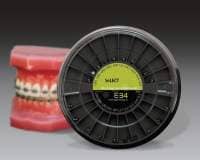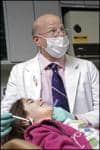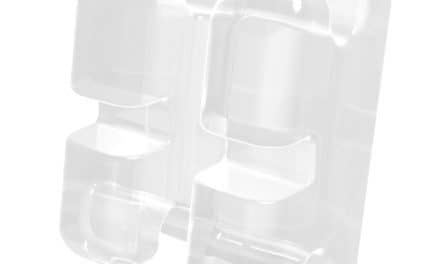James M. Reynolds, DDS, FACD, FICD, turns his orthodontic entrepreneurial skills to bacteria prevention with the SeLECT Defense Orthodontic System

Reynolds
Over the course of his 60-plus-year career, retired orthodontist James M. Reynolds, DDS, FACD, FICD, was never content with having a simple orthodontic practice. A born entrepreneur, the former AAO president set out to develop products—including a mold-injected buccal tube and the first clear ceramic bracket—that helped advance orthodontics and improved patient care.
His latest contribution to the orthodontic field, through his Lubbock, Tex-based company Element 34 Technology Inc, is a line of dental products known as the SeLECT Defense™ Orthodontic System. SeLECT Defense is an antimicrobial sealant and adhesive that incorporates selenium—a naturally occurring essential mineral—to combat plaque-causing bacteria and to keep them from colonizing in hard-to-clean spaces on and around orthodontic braces. The SeLECT Defense line of orthodontic products includes a light-cure adhesive, band cement, primer, sealant, elastomerics, and brackets.
Reynolds recently talked to Orthodontic Products about how SeLECT Defense got started. how it works, and what other applications there might be for selenium.
Orthodontic Products: How did SeLECT Defense come about?
James M. Reynolds: In 2006, I attended a seminar at Texas Tech University where a man on the program talked about how they had developed this process with selenium that eliminates the growth of bacteria. It sounded pretty interesting.
In addition, there was a company, Selenium Ltd, down in Austin, Texas, that had come to Texas Tech and bought the rights to that technology. Selenium Ltd was looking for a dental company that could develop the possibilities. That’s how we got involved.
Through our company, Element 34 Technology, we spent about 4 years working with Texas Tech, investigating what selenium would do and what it couldn’t do. They didn’t know whether they could put it on anything or not. Selenium is organic, while metal is inorganic. They’re not compatible. We had to figure out a way to coat the metal. That took quite some doing, but we finally developed a technology to put this on metal (as well as ceramic) braces and brackets.
In addition, we found that we could apply it to the polyurethane rings that hold the archwire in place. These rings take on water and are a wonderful trap for bacteria in kids who use them and who don’t brush their teeth well. We found that we can treat that little O-ring with the selenium, and no bacteria will grow around that or on the brackets. And it’s just amazing.
SeLECT Defense can also be applied to prevent tooth decalcification that results when bacteria and plaque collect around the bracket and under the archwire. If the plaque stays on the enamel, it starts deteriorating in such a way as that it creates an acid that begins to cause an etching and first stage of decay on the teeth. And if it stays too long, when you take the braces off, you have nice straight teeth with dirty white decayed places up next to the gum. Not only does the selenium keep that from growing, it actually kills the bacteria, making the area a lot cleaner. We say now if the orthodontist will just put our sealant on the enamel, and then bond the brackets on top of that, they won’t have any problem with plaque. You can have plaque on your teeth, but if there’s no bacteria, there’s no damage. What we’ve done is eliminated the possibility of damage.
This is the cutting edge—the newest thing that’s been developed.

The SeLECT Defense brackets use selenium as an antimicrobial.
OP: How should orthodontists apply SeLECT Defense?
Reynolds: We recommend it be applied to the teeth, and to seal the teeth off right up under the gum. That keeps the plaque away.
Selenium doesn’t dissolve. It stays there, and it will be there for 2 to 3 years. When bacteria tries to grow, it cannot colonize, so it dies. The selenium goes back to sleep and just sits there and waits for the next bug to come in. It doesn’t need to be reapplied.
We have developed this sealant in such a way that after we put it on, every 3 months when the patient comes in for a regular appointment, orthodontists can use a black light and just look all away around the mouth to see if some of the sealant might have chipped away. If there is a little spot that needs to be reapplied, then just put a little dab on to seal it back up.
We also have another product—a pit and fissure sealant. When the enamel grows, there are pits and little cracks in the enamel. As soon as the tooth comes in—the 6-year molar, for instance—the pit and fissure sealer can be applied and it seals that chewing surface up so that the 5-, 6-, 7-, 8-year olds don’t have any cavities.
While similar sealants have been around for years, ours is superior because if a tooth has some decay that’s starting, then our sealant will take care of that new decay and keep it from happening. Otherwise, decay can happen under the sealant when orthodontists don’t realize that there’s actually a decay there first. So we’re killing it and at the same time protecting against any future decay.
OP: Does SeLECT Defense have FDA approval?
Reynolds: We do have FDA approval. We were told it would take at least 5 years, but apparently someone thought it was a pretty good product and we got our approval in a little over 6 months. We felt pretty smart or lucky—I don’t know which. We’ve worked with Texas Tech, as well as the University of Texas at San Antonio, to do a series of seven research projects. These research projects aimed to prove that SeLECT Defense works and to give the FDA something to look at.
We finished a study recently at University of Texas, San Antonio, that showed that if you properly seal the teeth there won’t be any decay on young kids’ teeth.
The mouth is such a wonderful laboratory. Split mouth studies are very effective, because we can put something on one half of the mouth and something else on the other half, and you’ve got an ideal situation. You get a perfect result: this works, this doesn’t work.
It makes us feel we’ve got a good product. The doctors, I think, will actually have happier patients in the long run if they don’t have the fussing with them during every visit.
OP: How can an orthodontist best incorporate this into his or her practice?
Reynolds: The beauty of it is that they don’t have to change their regular routine. Every doctor uses a bonding material to bond the teeth, and, in the past, a lot of them would bond the brackets on and then put a sealant around them. With SeLECT Defense, we recommend they just put it on each tooth—on the labial surface or on the lingual, if they are doing lingual orthodontics—and then bond on top of that. Our bonding material, which is a light-cured material, gives a double whammy as far as protection goes, because patients will receive the sealant and then the bonding material—two different applications there at the same time—which will prevent the growth of bacteria.
OP: Does use of SeLECT Defense require any additional training?
Reynolds: No. In fact, we’ve been doing what we call “lunch and learns.” We don’t have a sales force or anything, but if a doctor is interested, we’ll buy lunch for the office, take it in, and give a demonstration so the whole staff can understand what is happening and what is expected of them. We have doctors saying, “As of next Monday every patient we start on new treatment we’re going to put the selenium sealant on. We’re going to put that on, and we don’t have to worry.”
Application of SeLECT Defense might take a total of 20 minutes. It’s not time-consuming. And it doesn’t dissolve. That’s the beauty of it: it doesn’t leach or go away.
OP: Have you heard about any other applications for selenium?
Reynolds: A radiologist was telling us that one of the worst things that happens to radiation patients who have cancer in the jaw or somewhere in the head is that they develop dry mouth, which causes the teeth to start to decay. He said these patients should have their teeth sealed with selenium as they go through radiation so that the teeth don’t decay. We’re also beginning to work with the periodontists. My periodontist was in recently, and I was talking to him about it, and he said, “Jim, if this works, I’m going to quit scraping and start painting.” It’s a lot better to prevent it than to correct it later.
Some of our investors are medical doctors, and they agree this is cutting edge. It’s now being used on contact lenses and catheters—a lot of different things that they didn’t know at first that it would be good for. Every time you turn around, someone says why don’t we coat all the doorknobs in the hospital so they don’t transfer bacteria from room to room. There are so many possibilities, it’s kind of mind-boggling. I’m not smart enough to figure it out, but I can dream about it with everybody else.
James M. Reynolds, DDS, FACD, FICD, is a past president of the AAO. He co-authored Welcome to the World of Orthodontics, a practice-management and staff-training manual. He introduced powdered metal injection molding (MIM) of tubes and brackets, and later invented and earned three patents for aesthetic ceramic brackets. Reynolds has steered three companies, Zulauf, ClassOne Orthodontics, and Element34 Technology (SeLECT Defense).










